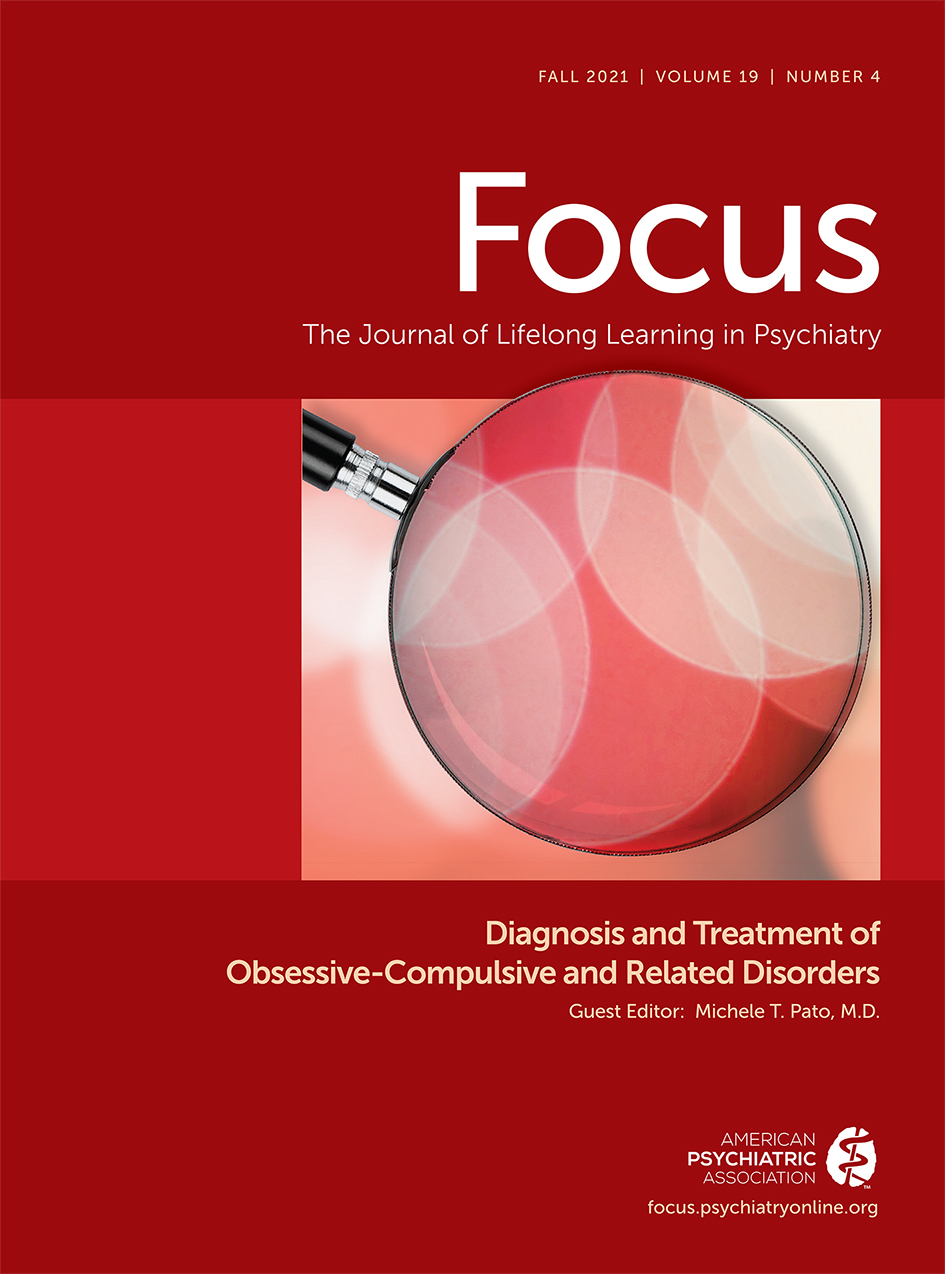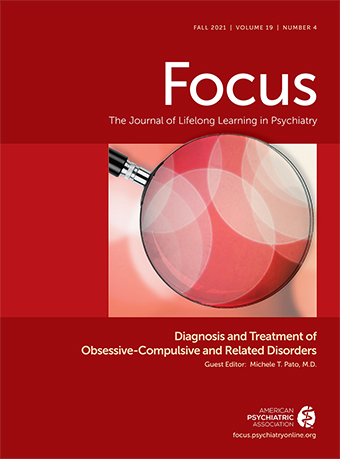This article provides an overview of previously discussed key topics on these disorders (
1), as well as new findings since our previous publication. New findings in this article, not covered previously, include recent data on prevalence from large-scale representative samples, subtyping of these conditions using latent phenotyping approaches, sex differences, and novel clinical trial data (e.g., milk thistle,
N-acetylcysteine [NAC] in picking).
Trichotillomania
Trichotillomania (hair pulling disorder) is characterized by the repetitive pulling out of one’s own hair, leading to hair loss and often to functional impairment (
2) (see
Box 1 for diagnostic criteria). Most people with trichotillomania commonly pull from the scalp, eyebrows, and eyelashes, but any bodily site with hair (e.g., the pubic region) can be affected (
3,
4). Pulling from multiple sites is common, and pulling episodes can last from a few minutes to several hours (
5).
Recent research has shed new light on the prevalence of trichotillomania. A study of university students (N=4,335) by means of an electronic survey found that 0.7% met the criteria for trichotillomania and that 4.8% reported subclinical pulling (
6). An online survey of participants (N=1,378) in the community found that 2% met the criteria for trichotillomania (
7). Finally, the first large-scale epidemiological survey of trichotillomania in the U.S. general population (N=10,169) found that 1.7% of 18- to 69-year-olds endorsed current trichotillomania (
8).
Onset of hair pulling is typically in adolescence, although onset of pulling behaviors can occur at any age (
5,
8). Trichotillomania has long been thought to be more common among females (
9), but this may be due more to who seeks treatment because it now appears that it may be distributed equally between the sexes in the community at large (
8). Trichotillomania also appears to have a similar clinical presentation across cultures (
10). Trichotillomania is frequently associated with reduced self-esteem and increased avoidance of social situations as a result of shame and embarrassment from the pulling and its consequences (
11,
12). Even though trichotillomania interferes with a person’s quality of life, most individuals (about 65% or more) never seek treatment (
4).
The clinical presentation of trichotillomania varies. Individuals may report one or many triggers for their pulling, including sensory triggers such as the feeling of the hair or the scalp; emotional triggers such as feeling anxious, bored, or angry; and cognitive triggers such as thoughts about hair and appearance or rigid thinking (
4,
5). Many patients report not being fully aware of their pulling behaviors, also referred to as
automatic pulling, whereas
focused pulling generally occurs when the patient sees or feels a hair that is “not right”; the hair may feel coarse, kinky, or out of place (
4,
5). Most patients pull with varying degrees of focused and automatic pulling, which can fluctuate over time.
Skin-Picking (Excoriation) Disorder
Skin-picking (excoriation) disorder is characterized by the repetitive and compulsive picking of skin, leading to tissue damage (
2) (see
Box 2 for diagnostic criteria). Although picking one’s skin is fairly common from time to time in the general population, clinicians must differentiate between normal picking and more pathological forms. The diagnostic criteria for skin-picking disorder require that picking be recurrent and result in skin lesions, thereby reflecting the frequency and intensity of the picking (
2). In addition, the clinical diagnosis requires that the picking result in the person feeling distressed or impaired.
Community prevalence studies in the United States have found that skin-picking disorder is relatively common. In one study among people (N=354) randomly selected in public places, 63% of respondents engaged in some form of picking, and 19 (5.4%) reported significant picking with associated distress or impact (
13). Another study (N=2,513) found that 1.4% of respondents picked to the point of having noticeable skin damage and had distress or psychosocial impairment as well (
14). In a Brazilian study, 7,639 participants recruited by means of an online survey found that 3.4% endorsed current probable skin-picking disorder (
15). Finally, in a large U.S. community survey (N=10,036), 213 participants (2.1%) identified as having current skin-picking disorder (
16).
Research has suggested that the onset of skin-picking disorder may occur in adolescence or middle adulthood (
17). The clinical characteristics of skin-picking disorder appear to be the same across age cohorts and cultures (
18). Many individuals with skin-picking disorder report that the behavior began with the onset of a dermatological condition such as acne, but the picking continues even after the dermatological condition clears.
The phenomenology of skin-picking disorder bears striking similarities to that of trichotillomania. Individuals with skin-picking disorder spend a significant amount of time each day picking at their skin, with many reporting that the picking behavior occupies several hours each day (
19). Although the face is the most commonly reported site of picking, other areas, such as the hands, fingers, arms, and legs, are also common targets. Picking in more than one body area is normal, with one study finding that people picked at an average of 4.5 sites (
18,
19). The time spent picking, as well as the consequences of picking, such as scarring, results in dysfunction related to work and social activities (
20). Triggers to pick vary greatly between individuals, and multiple triggers are the norm. Stress, anxiety, time away from scheduled activities, boredom, and feeling tired or angry have all been reported as triggers (
18).
Clinical Characteristics Among Children and Adolescents
Trichotillomania has a peak age of onset of around 12–13 years, but it can begin at any age. Skin-picking disorder appears to have a more variable age of onset, with an unclear peak. The majority of research into these conditions has focused on adult samples; as such, knowledge of childhood forms is relatively limited. Dimensional forms of body-focused repetitive behaviors appear to be higher among children than among adults. For example, in a study using the Child Behavior Checklist, 10%−40% of children reported picking their skin, nose, or both (
21), whereas rates of hair pulling in children are not known. In children with trichotillomania, comorbid conditions appear similar to those for adults, with anxiety or mood disorders and attention-deficit hyperactivity disorder (ADHD) being common (
22), albeit with lower rates of anxiety or mood disorders than for adults (
23).
Early case reports of trichotillomania suggested that hair pulling in very young children tended to resolve spontaneously without the need for intervention. This may mirror more recent findings from the Trichotillomania Impact Project in Young Children (TIP-YC) (
24). The TIP-YC involved an online survey of parents with young children with a hair-pulling problem. The authors found that the clinical profile of childhood hair pulling seemed similar to that for adults (e.g., in terms of impairment); however, very young (defined as preschool-age) children had less impairment and fewer comorbid conditions.
Commonalities Between Trichotillomania and Skin-Picking Disorder
Much remains unknown about the neurobiological underpinnings of these two disorders. Because both picking and pulling may cause discomfort, recent research has questioned whether people with these disorders have dysfunction in pain perception. One means of understanding pain perception is via the cold pressor test; it is generally understood that noxious cold stimulation applied to the upper limbs is associated with activation of the amygdala and anterior cingulate cortex, regions classically implicated in aversive emotional processing, and may also implicate the hypothalamic-pituitary-adrenocortical axis (e.g., an increase in cortisol). In the case of both skin-picking disorder and trichotillomania, participants appear to exhibit a similar dampened autonomic response to pain (
25,
26). Neuropsychological studies have also shown that patients with trichotillomania and skin-picking disorder exhibit deficits in cognitive abilities that are linked to the functioning of the frontal lobe and its related frontosubcortical structures, such as problems with motor impulsivity (
27,
28).
Neurobiologically, trichotillomania and skin-picking disorder appear to share similar structures and functions that have been implicated in both disorders. Structural abnormalities of subcortical regions involved in affect regulation, inhibitory control, and habit generation appear to play a key role in the pathophysiology of trichotillomania (
29). In one functional neuroimaging study, patients with trichotillomania exhibited dampening of nucleus accumbens responses to reward anticipation (but relative hypersensitivity to gain and loss outcomes) compared with patients in a control group (
30). Other neuroimaging studies have found disorganization of white matter tracts involved in motor generation and suppression (i.e., bilateral anterior cingulate and right orbitofrontal and inferior frontal cortices) with both disorders (
31,
32). Research has also indicated that the cerebellum, which contributes to cognitive and affective aspects of behavior, may be implicated in both skin-picking disorder and trichotillomania (
33,
34).
Psychological theories of etiology are also remarkably similar for both disorders. Because negative emotions such as anxiety, tension, and sadness often precede pulling and picking episodes, the question arises as to the role of these behaviors in regulating emotional states or stressful events. Therefore, picking and pulling may function as a means for the person to escape from or avoid aversive experiences, and the temporary reduction in these negative emotions maintains the behavior through a negative reinforcement cycle (
35). Studies that have measured emotional regulation in individuals with and without pulling and picking have found that individuals have greater difficulty regulating negative affective states than control individuals (
36,
37). In a related fashion, boredom may also trigger picking and pulling for some individuals. This has led some to hypothesize that pulling and picking may similarly help to adjust negative emotions brought on by a feeling of perfectionism characterized by an inability to relax (
38). This theory suggests that the perfectionism leads to feelings of frustration, impatience, and dissatisfaction when standards are not met and to boredom when productivity is impossible. Picking and pulling may therefore function as a means of releasing tension generated by these emotions. Pulling and picking are perhaps positively reinforced by a feeling of taking action.

